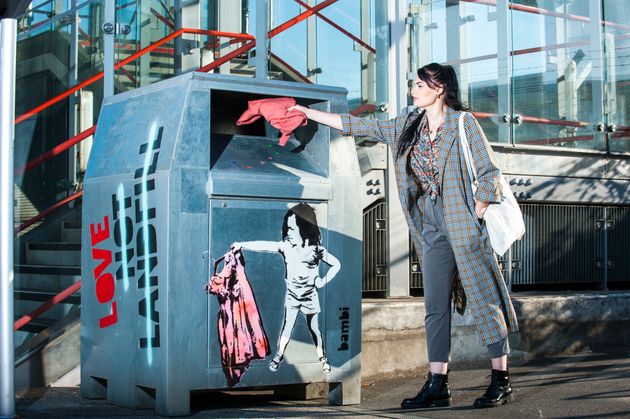A new campaign launched with some help from “the female Banksy” is encouraging people to bin their old clothes – but for recycling, not landfill.
Recycling banks have been installed around London, decorated by the street artist Bambi, whose “Lie Lie Land” mural of Theresa May and Donald Trump made headlines last year.
The #LoveNotLandfill campaign aims to raise awareness of the damage our fast fashion habit might be having on the environment and to change it for good.

Bambi’s bins will appear in five locations around London, including Topshop on Oxford Street and Westfield in Stratford, and will stay in place for at least six months. Their location aims to grab the attention of UK shoppers who buy 38 million items of clothing every year – and throw away 11 million.
Love Not Landfill, which is funded by the European Clothing Action Plan and London Waste And Recycling Board, says a third of people aged 16-24 have never used a clothes recycling bank before and that it wants to “slow down the pace of fast fashion”.
So what can you do with your clothes if you don’t chuck them in the bin?
Give them to high street shops. Struggling to find a local charity shop? Plenty of high street retailers such as H&M, & Other Stories and Marks & Spencer, host ‘shwop’ boxes to put your donations in. These garments are then dealt with in one of three ways: sold as second hand, reused to turn into other items, or recycled. Or if you’re in London, check out one of the Love Not Landfill bins in Topshop, Oxford Circus; Beyond Retro, Dalston; Ealing Broadway Shopping Centre; Westfield London and Stratford City (from late September)
Recycle with the council. Check to see if your local council collects clothes and textiles to be recycled – the details are normally on their website. The nationwide campaign Recycle Now says you can normally drop these off at recycling points or clothing and textile banks in supermarkets and local car parks. Find your nearest one using its Recycling Locator tool.
Donate them to charity shops. If you’re not invested in getting a monetary return for your items, then consider taking them down to your local charity shop. Research by Oxfam found that 49% of people believed worn out items can’t be donated, but this isn’t the case. Oxfam accepts all good quality or clean clothing and shoes (including vintage and retro items), even bras. It also takes wedding dresses and accessories. The only thing it won’t accept is anything broken, dirty, incomplete or unsafe.
Swap your clothes. If you prefer the idea of a wardrobe refresh without spending any more money, then consider attending – or even hosting – a swapping event. Clothes swapping, known as ‘swishing’, involves everyone bringing their old items to trade for new clothes. This is recycling made enjoyable and there are swishing parties all over the country, listed here.


